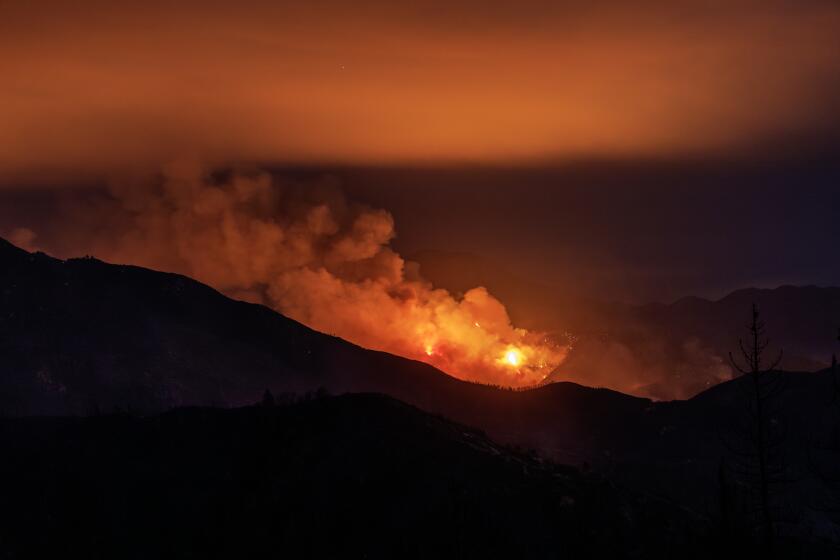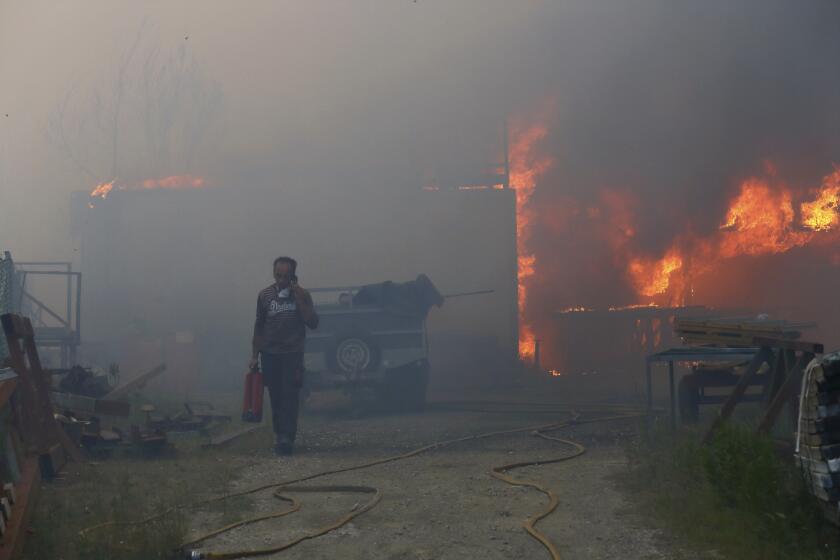A reborn landscape emerges in park
The catastrophic Cedar fire that burned Cuyamaca Rancho State Park to a char three years ago is receding into history.
The caravans of orange tree-service trucks that clogged California Route 79 in November 2003 as overworked crews felled hundreds of dangerous burned trees on both sides of the road in the smoldering park are long gone. The ceaseless dirge of chain saws has faded to silence.
California 79 has been repaved. It’s now called Steven Rucker Memorial Highway, after the Marin County firefighter who died nearby in the conflagration.
Since the Cedar fire, nearly 29,000 other fires, including the recent and deadly Esperanza blaze in Riverside County, have burned about 1.2 million acres of wild land in California, according to the California Department of Forestry and Fire Protection and the U.S. Forest Service.
None, however, has been as destructive as the Cedar fire, which killed 15 people, destroyed 2,200 houses and burned more than 300,000 acres. It was particularly thorough in its embrace of Cuyamaca Rancho, sparing only 300 of the park’s 26,000 acres and all but obliterating its majestic mountain forest of luxuriant oaks and towering pines, some half a millennium old.
Compared to the Cedar fire, the dramas now unfolding as nature reconstitutes itself are slow and quiet but will determine what exists in the park’s meadows and on its mountains in the distant future. They give insight into what is occurring in all of California’s burned wild lands, where devastated forests will require a human lifetime to return to anything like pre-fire conditions -- if they ever do.
Subtle changes
Although the park’s most striking visual features -- acre upon acre of dead, black pines, many limbless and chiseled to points by the flames -- remain, less attention-commanding changes have been occurring.
On Cuyamaca Peak, the park’s highest point, the ground was burned bare and blanketed in ash immediately after the fire. By spring 2005, it wore a green carpet of ground-hugging bracken fern. Now, mountain lilac, a shrub uniquely adapted to coming back from a fire, rises like a bristling green tide 2 and 3 feet deep around the spires of dead trees.
Park officials’ biggest concern -- their deepest longing -- is for the kingly pines that were Cuyamaca Rancho’s hallmark. In the park’s lower reaches, pines were killed at rates approaching 100%. Unlike fire-resistant oaks, which resprout from limbs and roots, pines can regenerate only from seeds -- a far dicier strategy.
Michael Wells, who wrote his doctoral dissertation on the park’s pines, recently went up the peak in search of a patch of inch-high baby pines he had discovered growing in ash the first spring after the fire. A year later, after the heavy rains of winter 2005, he was delighted to find the seedlings had grown well in the newly abundant sunlight at the feet of charred remains of their parents.
Wells, now superintendent of the state’s Colorado Desert Park District, which includes Cuyamaca Rancho, found what he was looking for. The small pines had survived. One Coulter pine seedling had grown to thigh height. A couple of dozen others were 2 feet tall.
“This is probably his third year,” Wells said of the largest seedling. “This should be a survivor.”
Even more encouraging was the sight of smaller pines, about 6 inches tall. “These are seedlings that probably came up a year after the first ones,” he said.
“These will be 15 feet tall in about nine years, which is about when Coulters begin producing seed-bearing cones of their own. This area will be a pine forest again. In 40 years it will be similar to what was here before. What I’m hoping is we’ll be finding little pockets like this spread all over the park.”
Wells’ hopes were dashed, however, on the park’s lower-lying West Mesa, a graveyard of standing, dead pines, their peeling black bark displaying, in a Dalmatian pattern, the white wood beneath.
The dead forest was now afloat on a sea of mountain lilac and nonnative grasses such as mustard and wild oats. Where Wells had done his dissertation study of Coulter pines, the open ground had been accessible to hikers after the rainy winter of 2005. Now it was impassable, thanks to thick mountain lilac and early arriving mountain mahogany. No pine seedlings had a chance here.
Farther down the slope, numerous oaks that in 2005 had sprouted isolated balls of green shoots on their upward-turned limbs now seemed to be wearing verdant overcoats on their blackened frames, the green balls having grown together over the last 18 months.
“This will be Ceanothus [mountain lilac] for 40 years, and farther to the south an oak savanna,” Wells said.
Elsewhere on the mesa, at a site where the Cedar fire killed 70 deer, tall, dry grasses swayed around scattered skeletons. In spring 2005, dozens of healthy pine seedlings, some already 14 inches tall, grew here. Now there was no trace of them. They had succumbed to the dry weather that has prevailed for the last year and a half.
Baby trees are not the only ones dying. An estimated 1 million of the park’s trees were killed in the fire, but Laura Itagowa, the park’s recently retired superintendent, estimated that an additional 10% of that figure have succumbed -- many in the last year -- in a delayed die-off probably related to a combination of fire damage, drought and, in the case of pines, bark beetle infestation.
“The greatest mortality we’re having now is in oaks, and we don’t know why they appeared healthy and green and a month later they’re all brown,” she said. “I am seeing green pines -- trees that were very healthy after the fire -- dying. The top half is starting to die off, and that’s most likely drought and bark beetles. It just breaks my heart.”
Populations differ
Wildlife in the park by and large has rebounded, albeit with demographic changes.
For the first two years after the fire, mountain lions, which had made heavy use of Cuyamaca Rancho, tended to visit the park only sparingly. “Now we have several lions -- certainly three that we know of -- and they’re using the park quite intensely,” said Walter Boyce, director of the UC Davis Wildlife Health Center, which is studying the mountain lion population in the area.
The reason for the increased lion activity is that mule deer, the big cat’s favored prey, have returned to at least their pre-fire numbers. With new, tender, low-lying vegetation everywhere, the deer have plenty of forage.
Smaller predators, such as coyotes, bobcats and foxes, are also in evidence, but in changed proportions to one another, said the San Diego Natural History Museum’s Scott Tremor, who is studying mammals in burned areas adjacent to the park.
“The bobcats haven’t moved back into the burned areas and coyotes are detected least often there, but we’re finding gray foxes are found most commonly in burned areas,” Tremor said. “It’s not what I would have expected. Maybe the foxes are small enough to move around in this new canopy [of mountain lilac], and maybe the coyotes are too large to do so.”
Another possible reason for the relative absence of coyotes in burned areas, he said, is that rabbits, which prefer denser cover than currently exists, have yet to return in great numbers. Kangaroo rats, partial to the newly open areas created by the fire, by contrast, are proliferating, which explains the notable presence of red-tailed hawks that feed on them and hunt more easily in the absence of forest canopy.
Other bird species also have been favored by the changes. Mountain and California quail, house finches and the chipping, black-chinned and white-crowned sparrows -- all birds that favor low, new-growth shrubbery -- exist in abundance, said the museum’s Phillip Unitt, who has been conducting regular surveys of the park’s avian population.
Some birds, such as the Western bluebird and the orange crowned warbler, were initially reduced by the fire but now are increasing. “Some, like the bluebird, nest in tree cavities and even though the trees are burned, they still have cavities,” Unitt said.
Others, such as the Western tanager, a summer visitor that requires heavy tree foliage to conceal its nest, and the band-tailed pigeon, which in winter feeds on now-scarce acorns, have continued to decrease, as have mountain chickadees, one of the park’s most common birds before the fire.
Like those studying mammals, Unitt has been baffled by some developments. Tiny Lincoln’s sparrows -- wary, secretive birds -- were wholly absent in the first year after the fire. They’re now a common winter visitor, their bzzt-bzzt-pup-pup calls audible in the new thickets of mountain lilac.
“What’s peculiar is that historically they had never wintered at such high elevations,” Unitt said. “The question is, are they going to go away as quickly as they appeared? Were they doing something independent of the fire, or was it caused by the fire?”
Seeing the future
The future of Cuyamaca Rancho is being written now, and portends rolling hills with open vistas in place of today’s black-spiked slopes as dead trees inevitably topple. Oaks and chaparral are expected to dominate, and what relatively few pines grow will be confined to isolated patches, mostly at high elevations.
Unless human beings intervene.
Park officials are considering an option they’d rather not invoke: planting pine seedlings instead of letting nature take its course. “The thing that distinguished this fire was that it burned over such large areas with such intensity,” Wells said.
“Typically, you see a kind of mosaic where areas that are not badly burned then help reseed the burned areas. We don’t have many of those unburned sources after this fire,” Wells said.
“We might look at places like West Mesa to plant a small area and hope that will serve as a colonizing source for the rest of that area of the park.”
Humans, after all, contributed to the unnatural state of the forest by suppressing wildfires, which allowed the growth of a tall understory of vegetation that helped incinerate even the tall, mature trees that typically survive wildfires, said Shane Coles, a retired longtime ranger at the park.
“The forest was killing itself,” she said. “There was so much organic litter on the ground that it was suffocating.
“It was beautiful, but it wasn’t healthy.”
Bob Hillis, acting superintendent of the park, agreed that if human intervention turned out to be necessary, at least it would not be without precedent.
“There was nothing natural building up to the fire, with the fuel being allowed to accumulate,” Hillis said, “and maybe there’ll be nothing natural about the recovery.”
More to Read
Sign up for Essential California
The most important California stories and recommendations in your inbox every morning.
You may occasionally receive promotional content from the Los Angeles Times.










